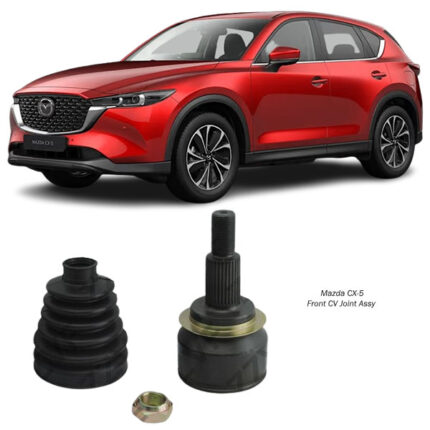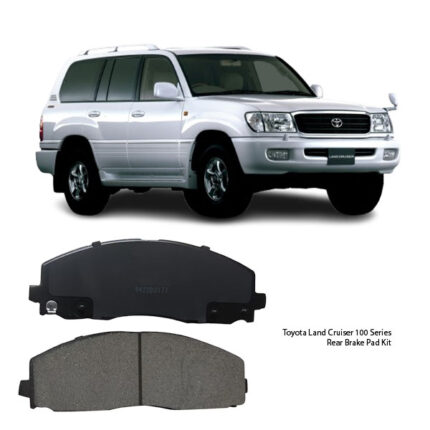Get Toyota Land Cruiser 100 Series Front Brake Pad Set D2177 in Kenya
A Front Brake Pad Set is a key component of the disc braking system, responsible for generating the friction needed to stop or slow down a moving mechanism. Designed to press against a rotating disc (rotor), these pads convert kinetic energy into thermal energy, effectively reducing motion. Since the front portion of a system typically handles the majority of the braking force due to weight transfer during deceleration, the front brake pads are often subjected to higher levels of stress, heat, and wear.
A standard front brake pad set includes two pairs of pads — one for each front wheel — and may also come with optional accessories like anti-squeal shims, wear indicators, or high-temperature grease, depending on the manufacturer. Choosing high-quality pads is essential for ensuring consistent, safe, and efficient performance.
Advantages of a Good Front Brake Pad Set
1. Reliable Friction and Stopping Power
Well-made front brake pads are manufactured using friction materials that offer superior grip across a range of temperatures and driving conditions. Whether during light use or emergency stops, good pads provide consistent and controlled deceleration.
2. Heat Resistance and Thermal Stability
Quality pads are designed to handle high heat loads without fading. Brake fade occurs when excessive heat reduces a pad’s friction ability. High-end pads resist this through improved materials and construction.
3. Low Noise and Vibration
Premium sets often include anti-noise shims, slots, or chamfered edges that help dampen vibration and reduce brake squeal, leading to smoother, quieter braking.
4. Reduced Brake Dust
High-grade pads generate less dust during wear. Brake dust can accumulate on nearby parts or surfaces, affecting cleanliness and potentially corroding other materials. Low-dust pads reduce maintenance frequency.
5. Longer Service Life
Durable construction means good front brake pads wear evenly and slowly, reducing the frequency of replacements and minimizing the chance of rotor damage due to uneven contact.
6. Rotor Protection
Some pads are designed with a balance of softness and toughness to ensure they grip well but do not eat into the rotors. This extends the life of both the pads and the rotors.
Disadvantages of a Poor-Quality Front Brake Pad Set
1. Inconsistent Braking
Cheap or low-grade pads may not provide uniform contact with the rotor, resulting in jerky or uneven braking. In some cases, this inconsistency can lead to dangerous delays in stopping.
2. Excessive Noise
Without proper shims or design considerations, inferior pads often squeal or grind during braking. This noise is not only annoying but may indicate damage or poor fitment.
3. Rapid Wear
Lower quality pads tend to wear down quickly, especially under frequent use or heavy load. This leads to more frequent replacements and reduced cost-efficiency over time.
4. Excessive Dust and Debris
Poor materials often generate large quantities of brake dust. This can dirty nearby components, reduce pad efficiency, and cause issues with wheel aesthetics or brake caliper wear.
5. Increased Rotor Wear
Hard or abrasive pads with uneven surfaces can cause the rotor to warp, glaze, or score. Rotor repair or replacement is significantly more expensive and time-consuming than pad replacement.
Signs of Worn-Out Front Brake Pads
Timely detection of worn front brake pads is essential for maintaining safety and optimal performance. Common signs include:
-
Squealing or High-Pitched Noises: A built-in wear indicator may produce a squealing sound when the pad reaches minimum thickness.
-
Grinding Sounds: A metallic grinding noise often means the pad material is gone and the backing plate is contacting the rotor.
-
Decreased Braking Performance: Increased stopping distance or spongy brake pedal feel can indicate insufficient pad material.
-
Pulling or Uneven Braking: If one pad wears faster than the other, the mechanism may pull to one side during braking.
-
Visible Pad Thickness Below 3mm: Physically inspecting the pads can confirm if they are below the safe operating limit.
-
Vibration Under Braking: Worn or uneven pads can cause pulsation or vibrations when the brakes are applied.
How to Replace a Front Brake Pad Set
Replacing front brake pads is a moderately simple task with the right tools and attention to safety. Follow these general steps:
Tools Required:
-
Jack and jack stands
-
Lug wrench
-
Socket wrench or spanner
-
C-clamp or caliper piston tool
-
Brake cleaner
-
New front brake pad set
-
High-temperature brake grease (if not included)
Step-by-Step Replacement Process:
-
Elevate the Front Section: Securely lift and support the unit using a jack and jack stands. Ensure it is on a flat, stable surface.
-
Remove the Wheels: Loosen and take off the front wheels to access the brake assemblies.
-
Unbolt the Caliper: Carefully remove the caliper bolts and slide the caliper away from the rotor. Do not let it hang by its hydraulic line.
-
Extract the Old Pads: Slide out the used brake pads. Examine their wear patterns and thickness for reference.
-
Retract the Caliper Pistons: Use a C-clamp or caliper tool to compress the pistons back into the caliper housing. This provides clearance for the new pads.
-
Install New Pads: Position the new pads in the bracket. Apply a thin layer of brake grease to the contact points if necessary.
-
Reassemble the Caliper: Place the caliper back over the new pads and secure it with bolts tightened to the correct torque.
-
Refit the Wheels and Lower the Unit: Mount the wheels back on, tighten the lug nuts, and lower it to the ground.
-
Test the Brakes: Gently pump the brake pedal to seat the new pads before operating under normal conditions.
Maintenance Tips for Front Brake Pads
Proper care and attention can significantly extend the life of the front brake pads and maintain system efficiency. Here’s how to maintain them:
1. Regular Inspection
Inspect the pads every few months for wear, cracking, or contamination. Pads should not be allowed to wear below 3mm of thickness.
2. Avoid Hard Braking
Frequent sudden stops generate excessive heat, accelerating wear and reducing pad lifespan. Smooth, gradual braking is gentler on pads.
3. Keep Brake Components Clean
Brake dust and grime can build up around calipers and rotors. Periodic cleaning using brake cleaner improves performance and reduces corrosion.
4. Replace Pads in Pairs
Always replace both front pads at the same time, even if one is less worn. This ensures even braking force and balanced wear patterns.
5. Lubricate Moving Parts
Apply high-temperature brake grease to slide pins and contact points during each pad replacement. This prevents binding and ensures smooth movement.
6. Bed-In New Pads Properly
Gradually apply the brakes several times after new pads are installed to transfer a thin layer of pad material to the rotor. This process, called bedding-in, improves performance and prevents glazing.
Follow us on Facebook for more parts.




